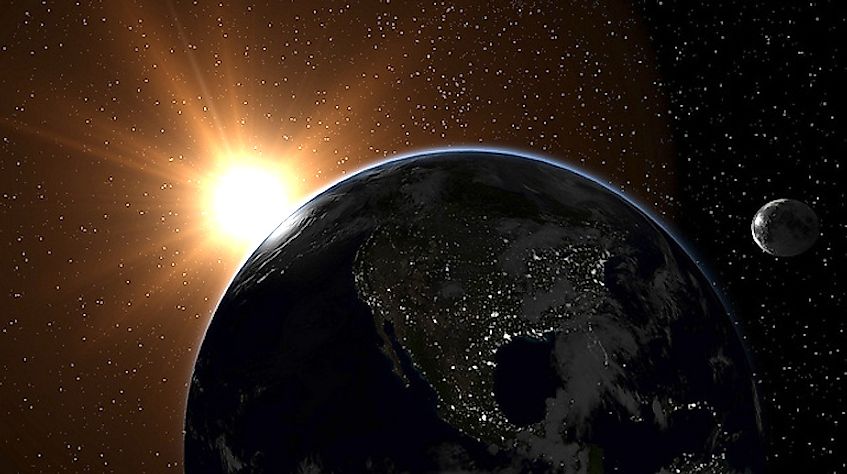The Past, Present, and Future Of Planet Earth

Our planet Earth formed around 4.6 billion years ago. However, the planet started supporting life only after 2.2 billion years of its formation. Since then, many species of microbes, plants and animals have evolved on our planet, and many became extinct over the years. Currently, Earth supports close to 8 billion human beings, 8.7 million species of other animals and close to 1.3 million plant species.
Formation Of The Earth And The Moon
The solar nebula hypothesis is the most widely accepted model related to the formation of the Solar System. It claims that the solar nebula formed as a result of the Big Bang, and gave rise to the Solar System. Shock waves emitted by a nearby supernova could have triggered the contraction of the solar nebula, and caused it to rotate. Soon, various protoplanets began to take shape from this rotating mass of interstellar gas and dust. Our planet also was formed by accretion from the solar nebula.
The moon, our Earth's only natural satellite, was formed about 4.5 billion years ago, suggesting that it formed after the formation of the Solar System. The most widely accepted theory regarding the creation of the Moon states that the satellite formed when a celestial body of the size of Mars struck the Earth, and matter was ejected from both the Earth and the colliding body into the Earth's orbit which condensed to form the Moon.
Late, Heavy Bombardment
In the early days of the Earth and other newly formed planets of the Solar System, about 3.8 billion years ago, a large number of asteroids would collide with these planets. These collisions left gaping craters on the surface of the planets. During such bombardments, the comets, being bearers of water could have contributed much of the water in the oceans of the Earth.
Early Life Begins
Early life flourished with the release of oxygen to the Earth's atmosphere about 3.5 billion years ago as a result of cyanobacterial metabolism in the Earth's oceans. When and how these cyanobacteria, the earliest forms of life emerged on Earth, is still a mystery. The cyanobacteria performed photosynthesis which released oxygen that was absorbed by the ocean water. This oxygen got fixed in the form of iron oxide that built up in the form of sedimentary rock deposits on the ocean floor. As the iron was used up at later stages, the oxygen was released and started building up in the Earth's atmosphere. Soon, life dependent on oxygen began to evolve.
"Snowball Earth"
For some time, about 650 million years ago, the Earth was completely covered in ice from the tropics to the poles. This "snowball earth" period coincides with the pre-Cambrian period. Life underwent a growth decline during this period, and only life forms in the rare ice-free pockets of the Earth's surface survived.
Life Explodes
During the Cambrian period, life forms on Earth underwent major evolutionary changes and species evolved at a rapid pace. Soft-bodied creatures evolved in early Cambrian and those with hard shells evolved later.
Mass Extinction Events
Though life continued to evolve and diversify on Earth, such periods of growth and evolution were interrupted by mass extinction events where many major forms of life on Earth got completely or partially wiped out, and many were newly formed. Asteroids impacts, climate change, volcanic eruptions, etc., are being held responsible for such events of mass extinction. Dinosaurs also got eliminated during one such event.
Pangaea Lost
About 200 million years ago, the Earth witnessed the breakdown of the Pangaea, a supercontinent that had formed about 270 million years back. Tectonic movements of the Earth's tectonic plates triggered this separation. Now, life evolved separately on the isolated landmasses, leading to the independent evolution of life forms.
We Live In An Interglacial Period
Starting 2.5 million years ago, the Earth underwent a series of glacial and interglacial periods, which marked the advance and retreat of glaciers respectively. Today, we are living in the Holocene epoch, an interglacial period that began about 11,500 years back.
Future Earth
Climate change induced by man is the biggest challenge facing Earth currently. However, though this activity of man might wipe out species from the face of the Earth, the planet will definitely revive and restore its balance like it has done for millions of years. However, it is the sun, as the scientists predict, that will ultimately destroy the Earth. As this aging star of the Solar System will run out of hydrogen, the fuel that sustains it, the Sun will lose its integrity and expand in volume, burning all that comes in its path, including life on Earth. Ultimately, the Sun would die, immersing the Solar System in darkness forever.
The Past, Present, and Future Of Planet Earth
| Rank | Event | Timeline (Ma=millions of years ago) |
|---|---|---|
| 1 | The Formation Of The Earth | 4,600 Ma |
| 2 | The Formation Of The Moon | 4,500 Ma |
| 3 | The End Of The Late, Heavy Bombardment | 3,800 Ma |
| 4 | Entry Of Oxygen To The Atmosphere: Beginning Of Early Life | 2,400 Ma |
| 5 | Snowball Earth | 650 Ma |
| 6 | Diversification Of Life | 545 Ma |
| 7 | Beginning Of Mass Extinction Episodes | 450 to 440 Ma |
| 8 | Break-down Of The Pangaea | 200 Ma |
| 9 | Advance And Retreat Of Glaciers | 2.58 Ma |
| 10 | Future Earth (Sun will destroy Earth) | Billions of years from now. |











